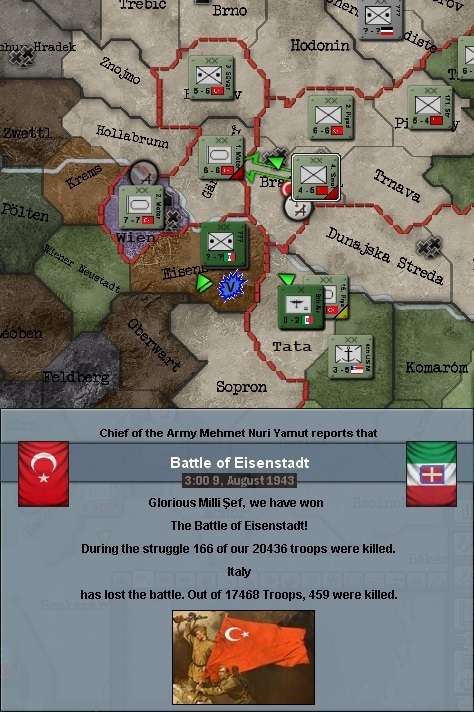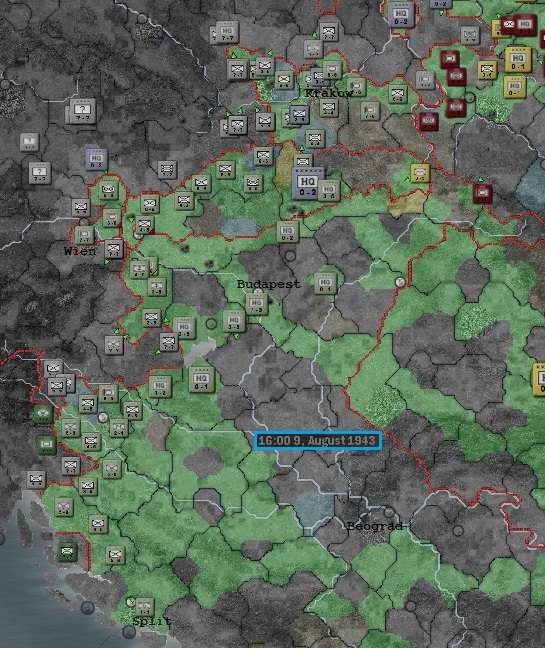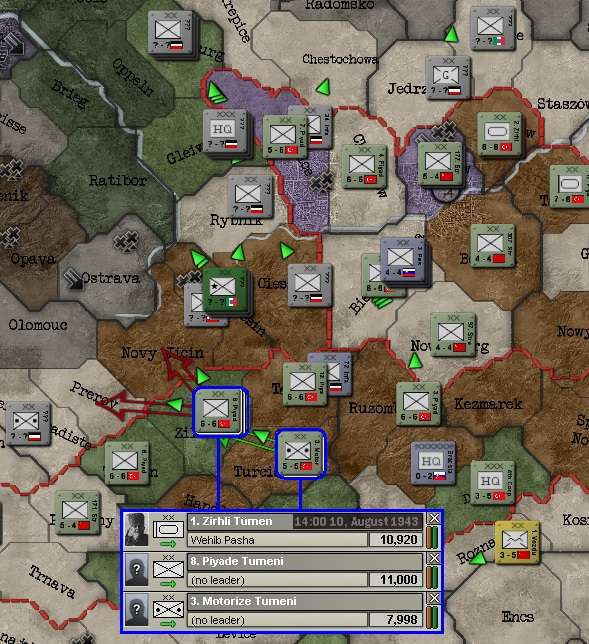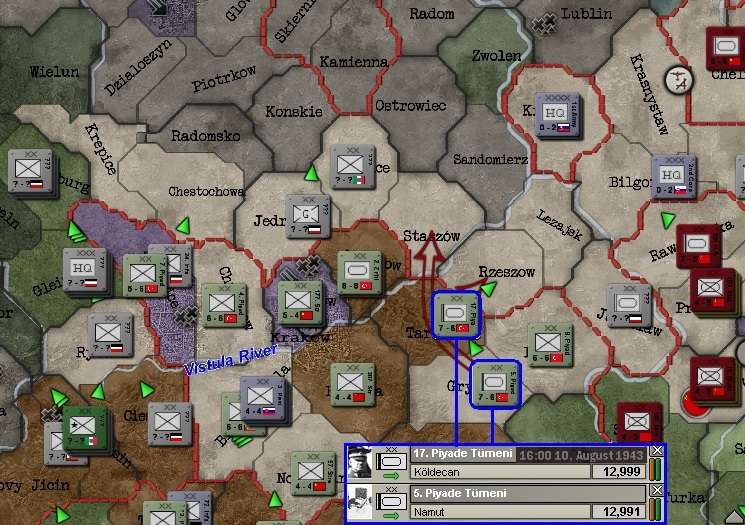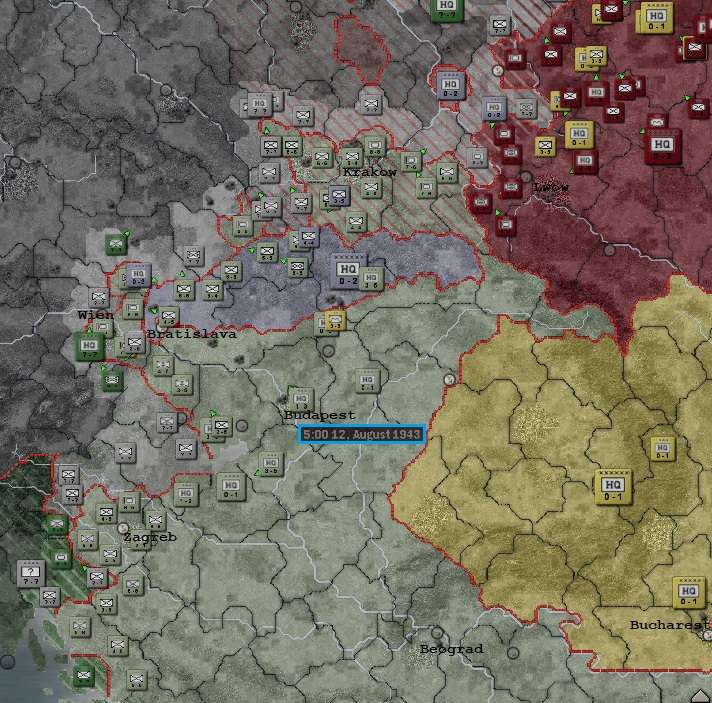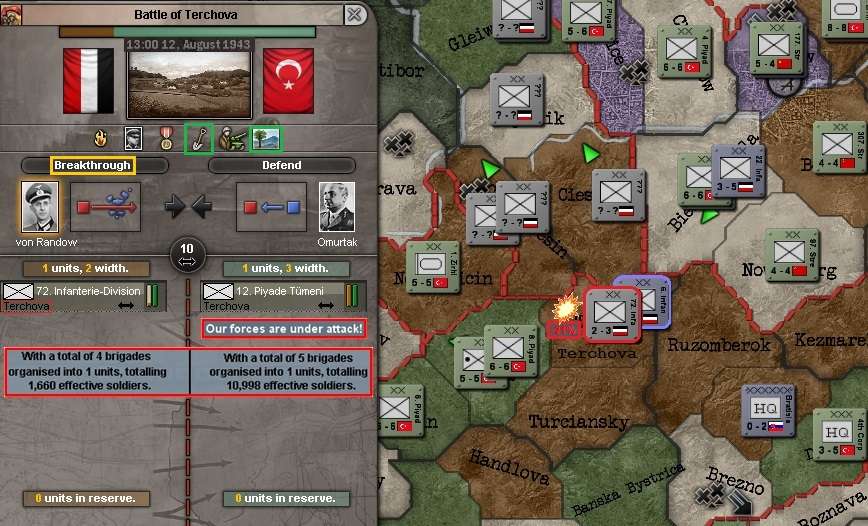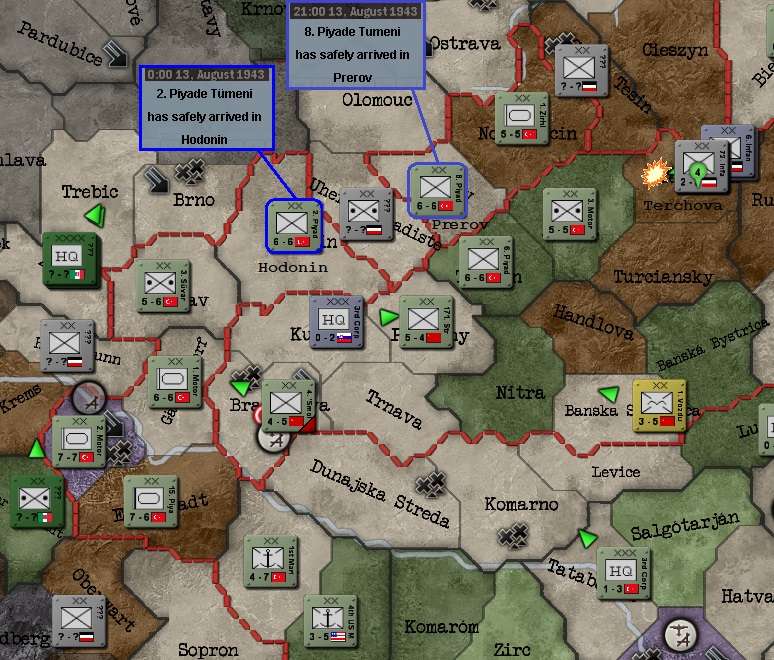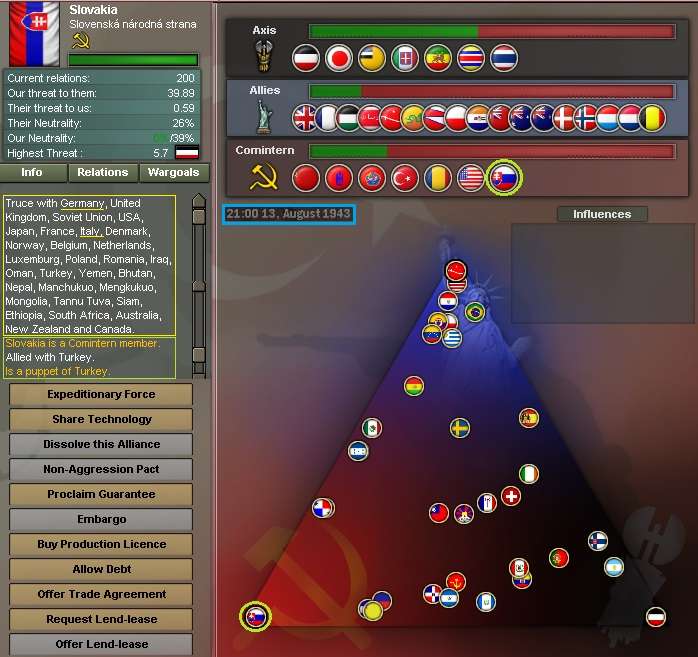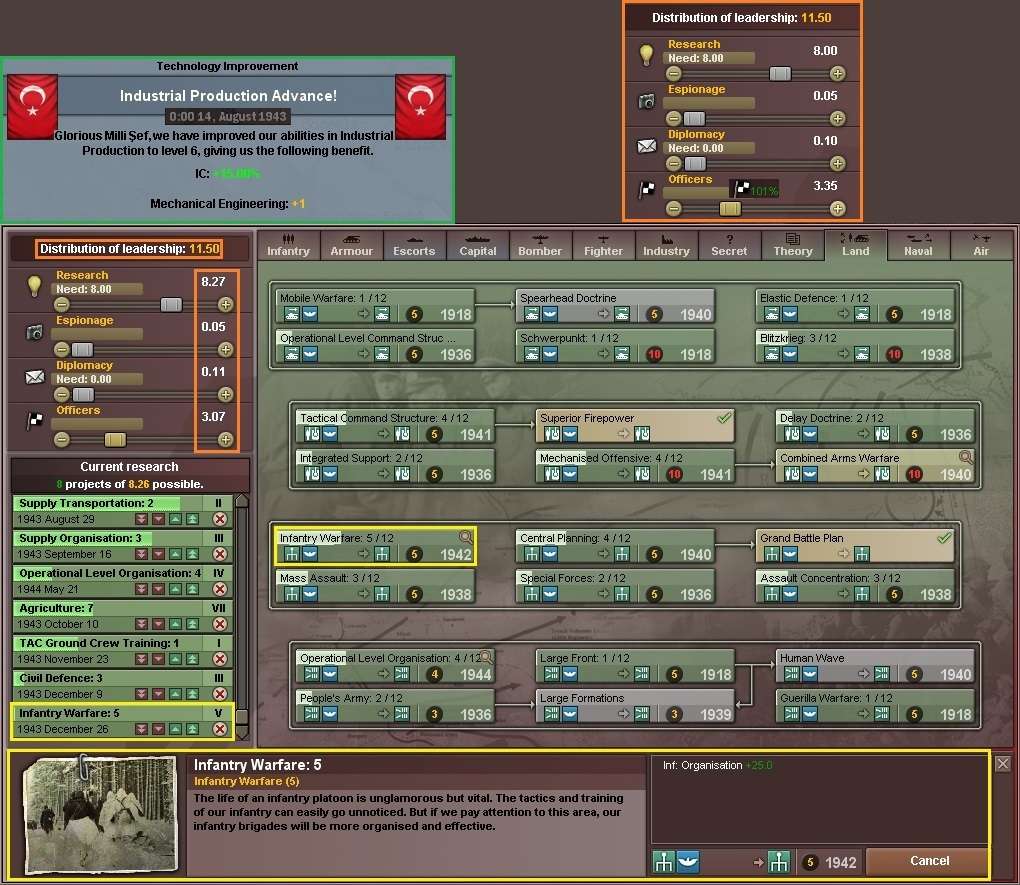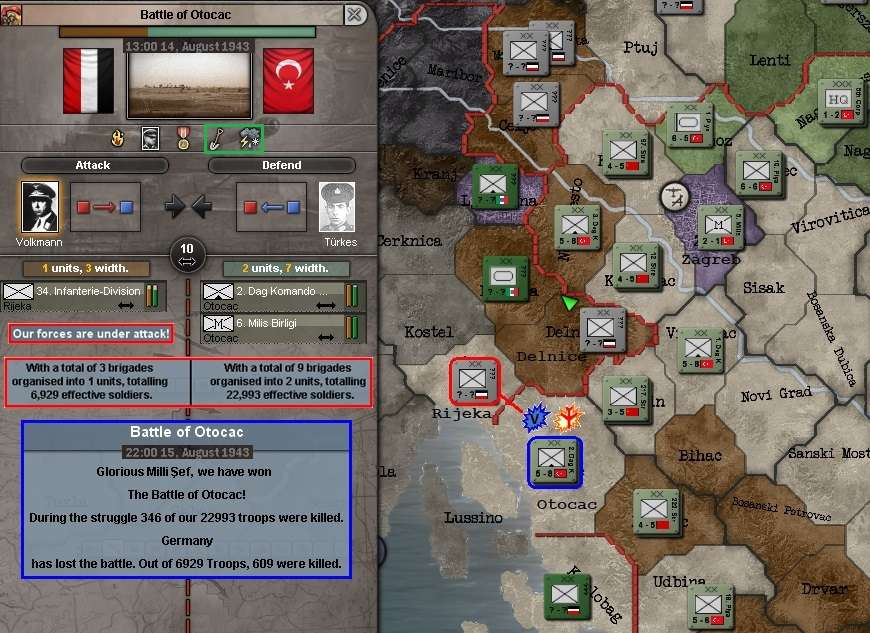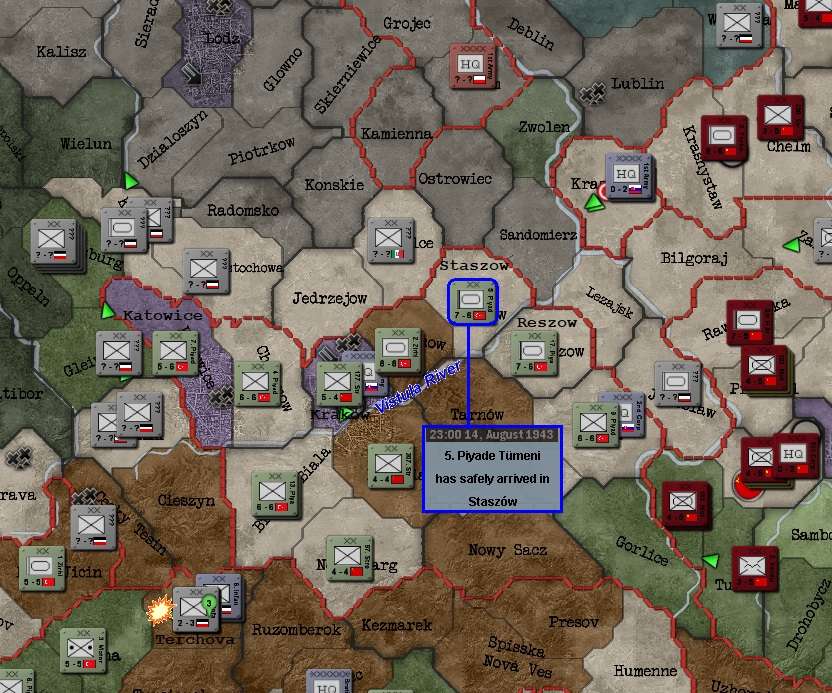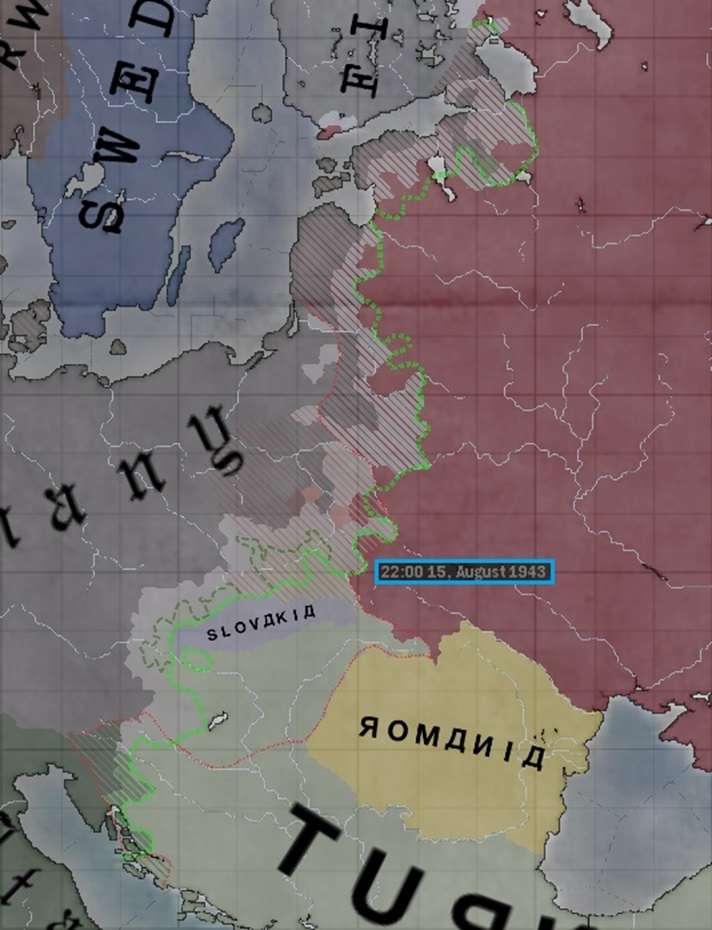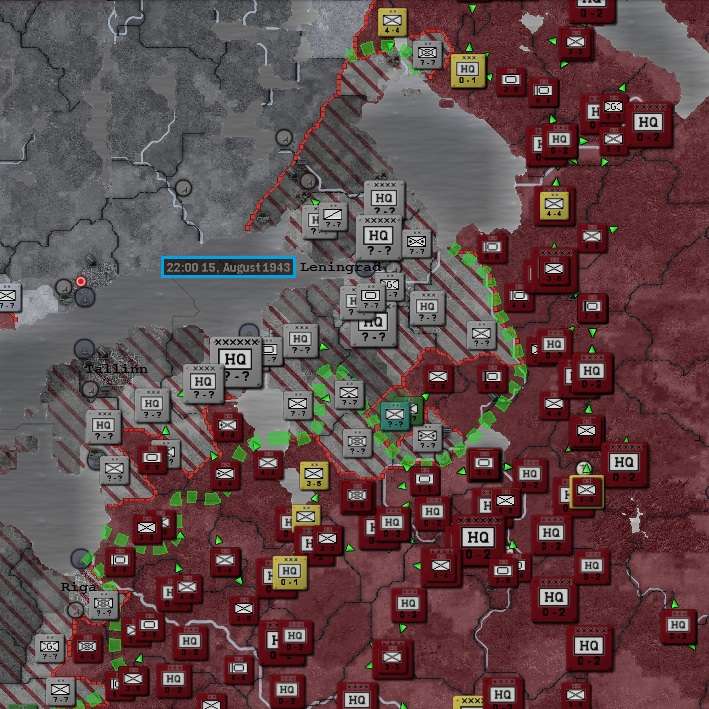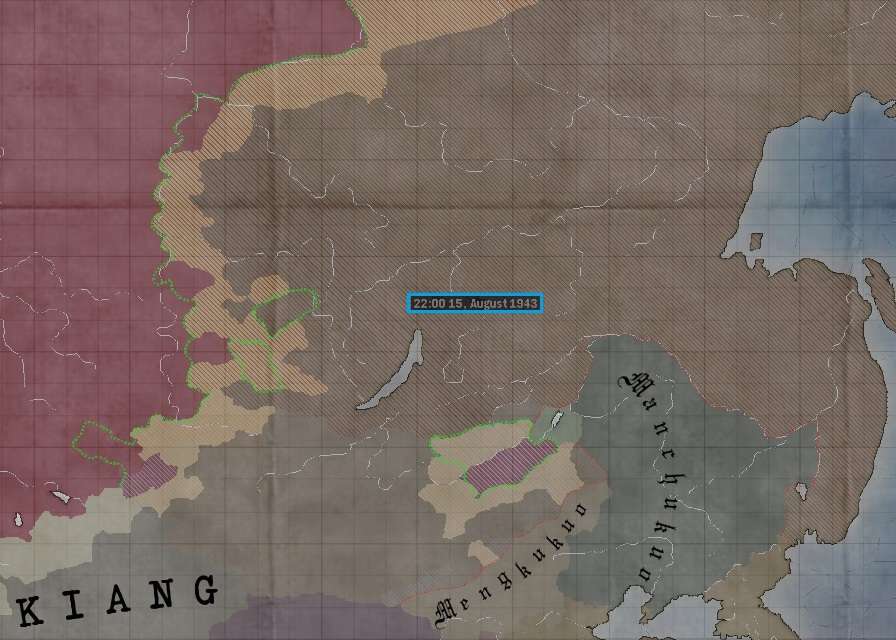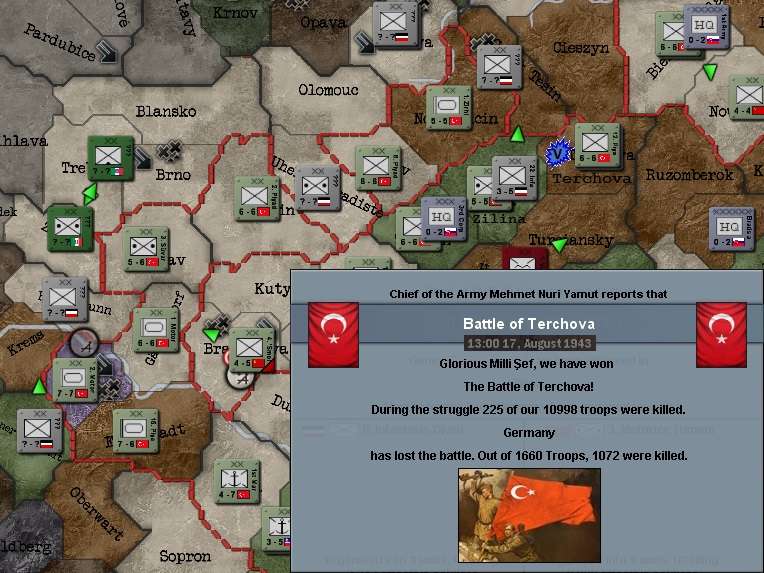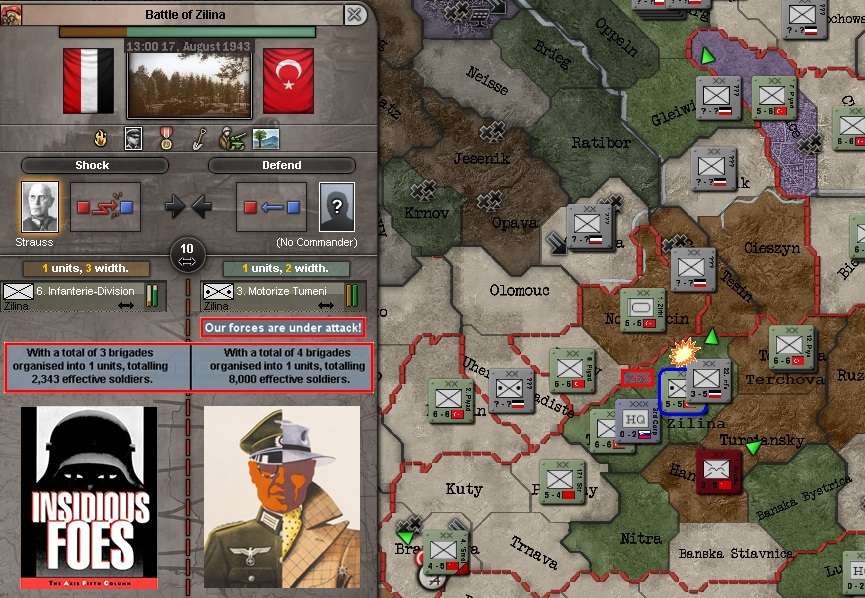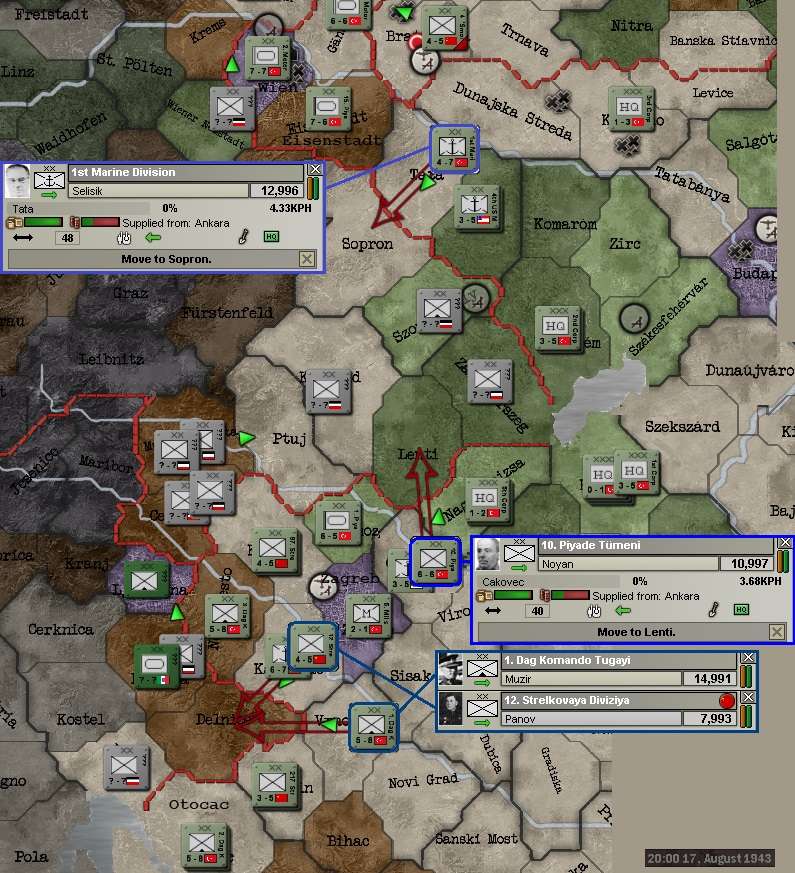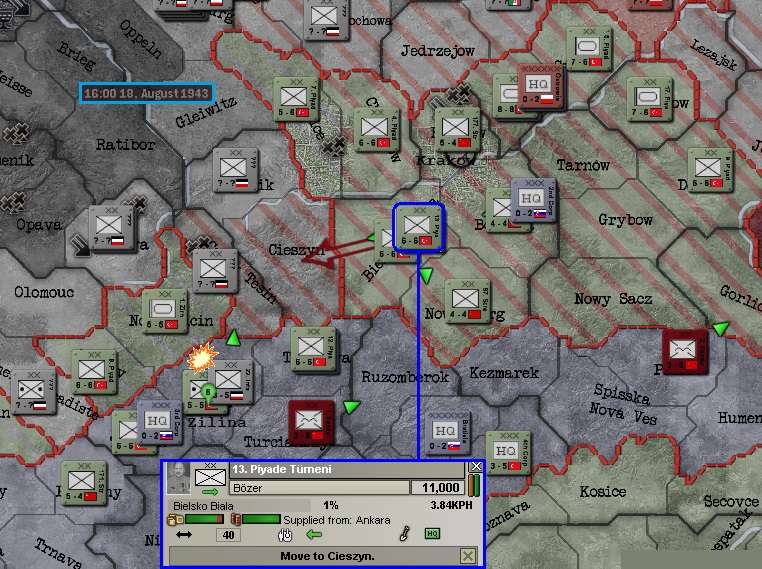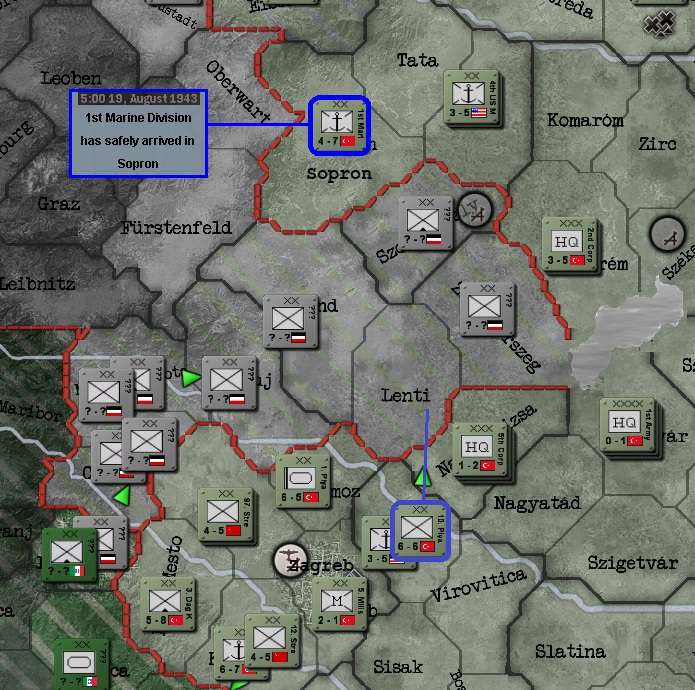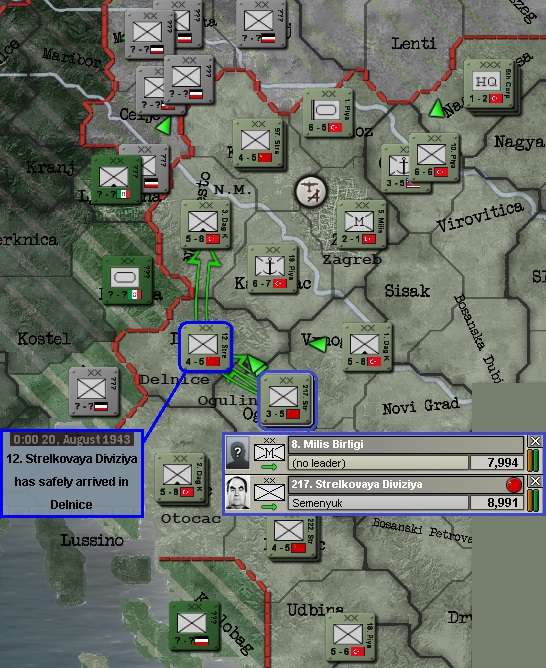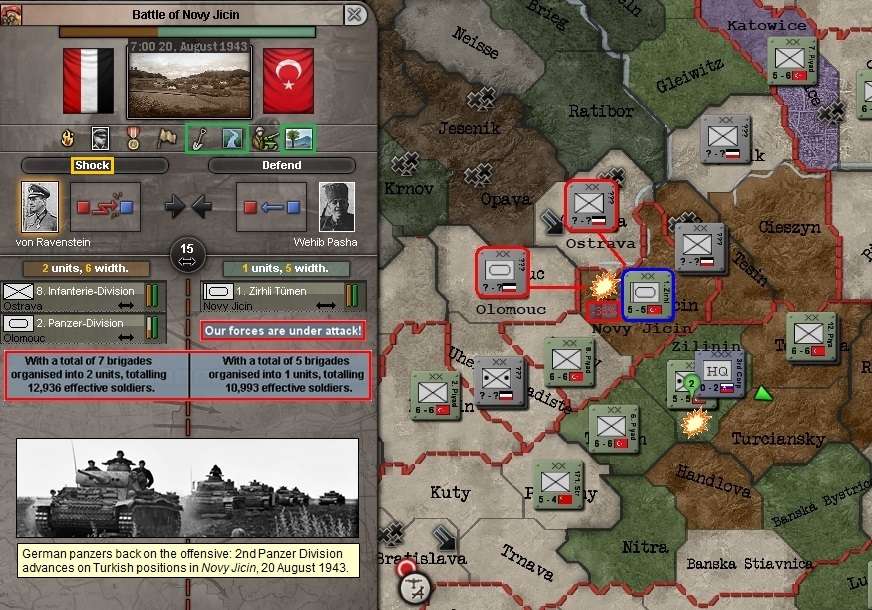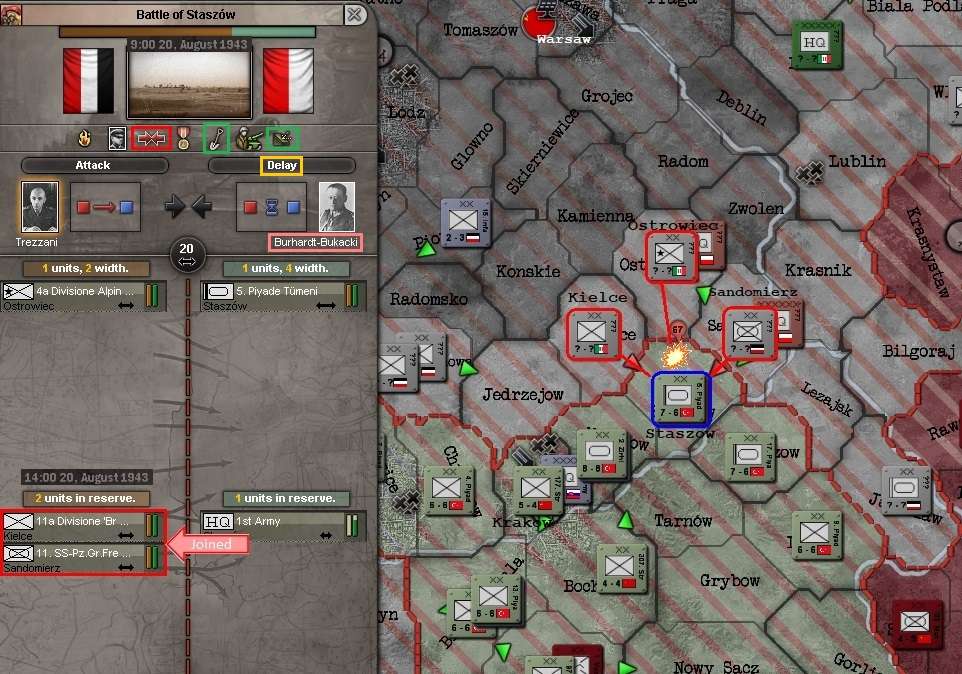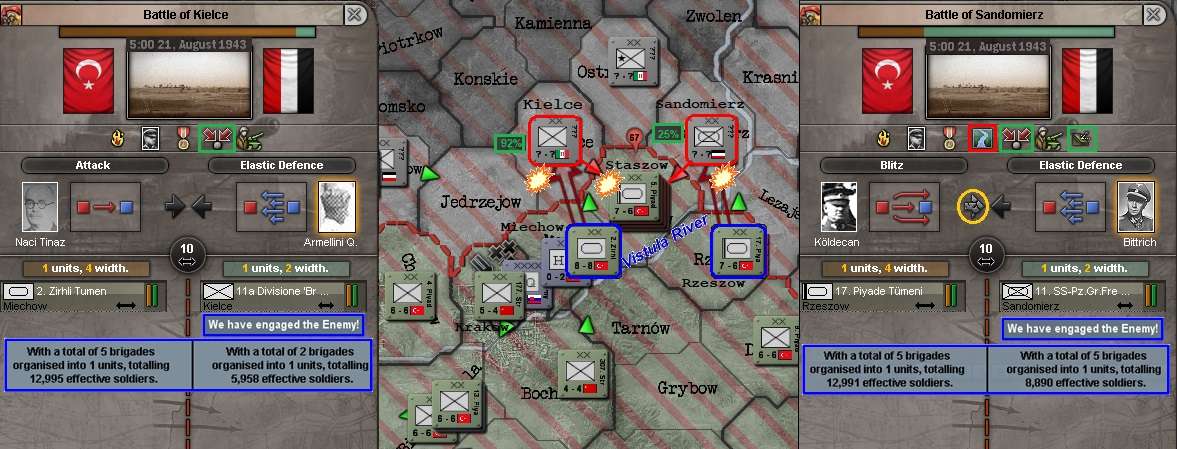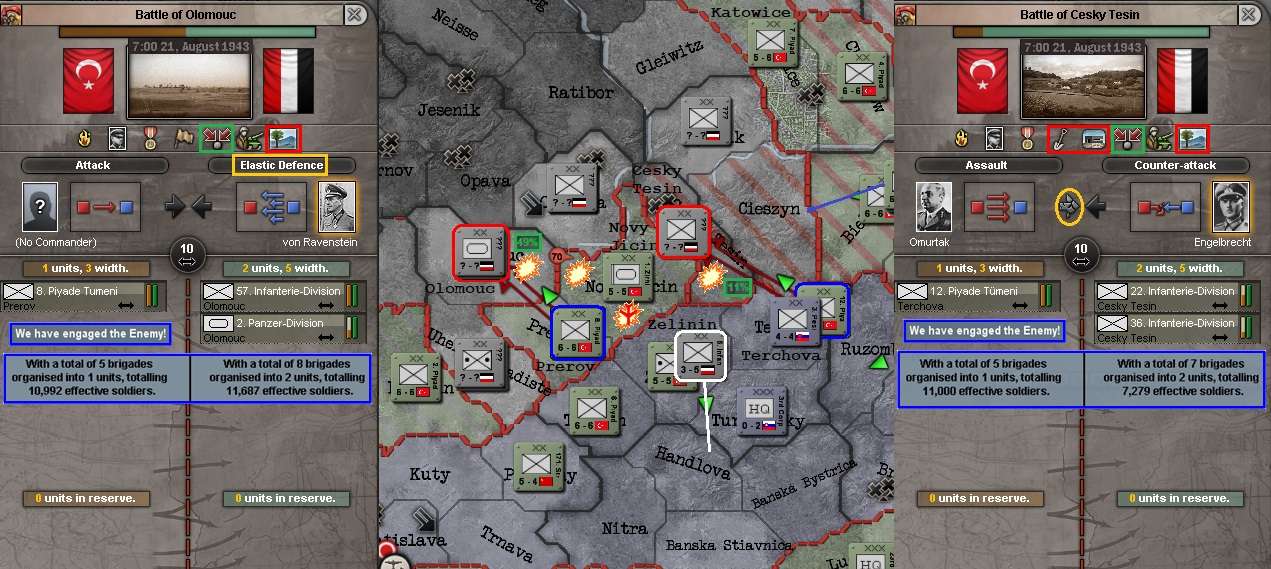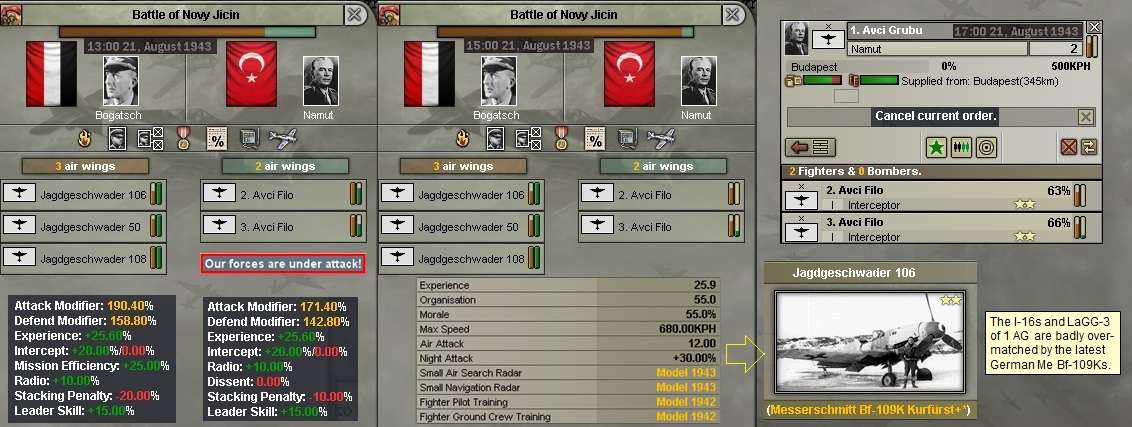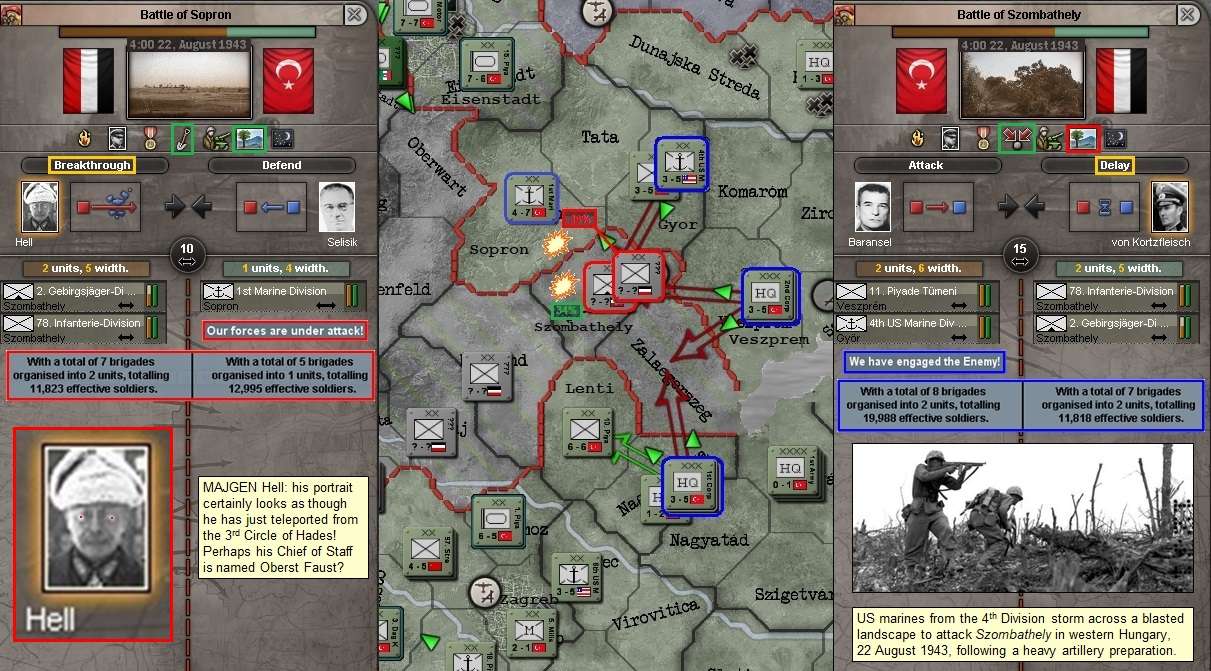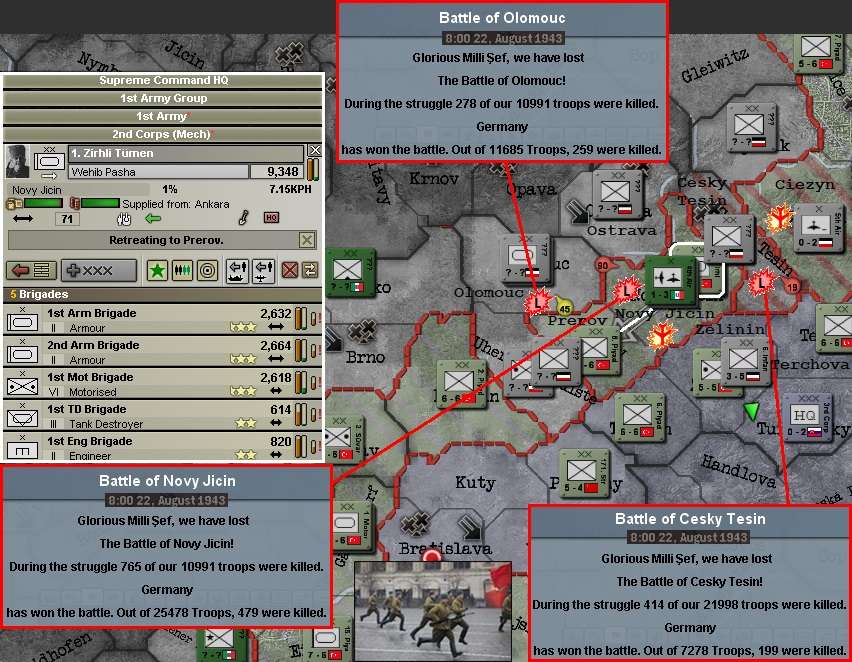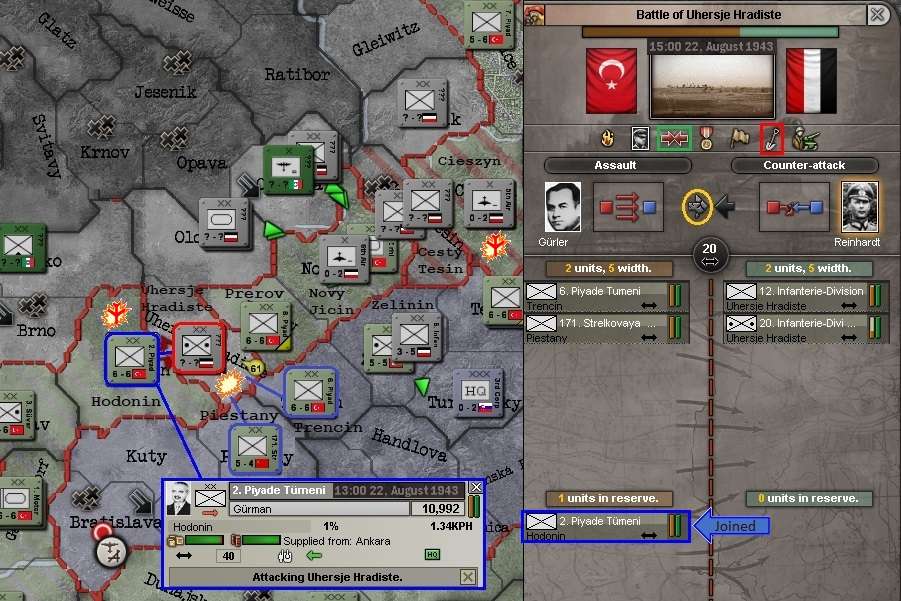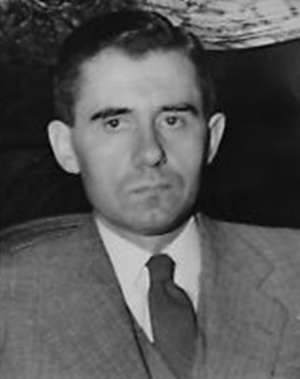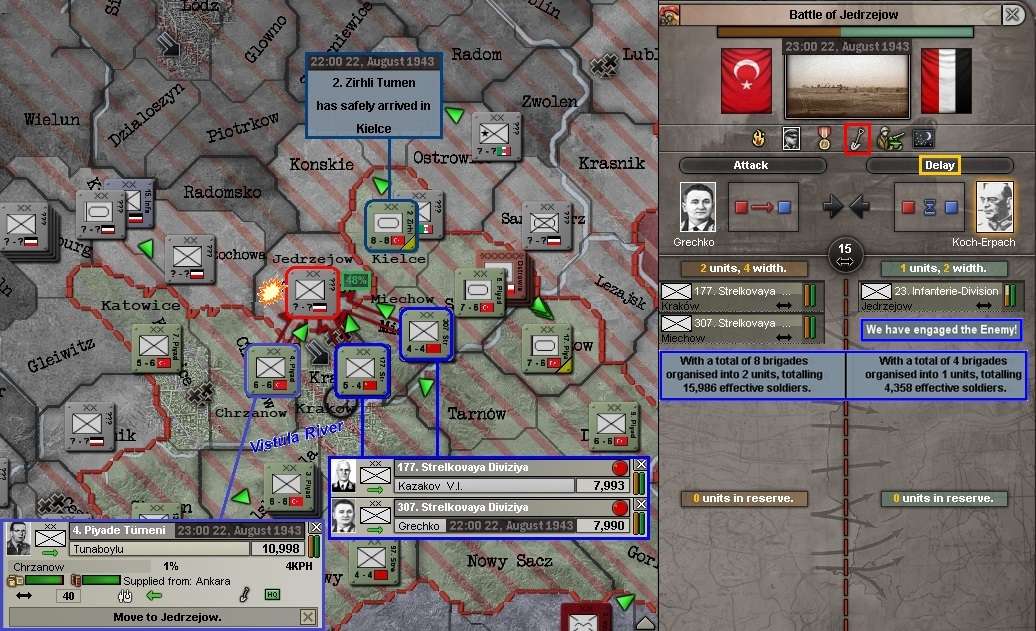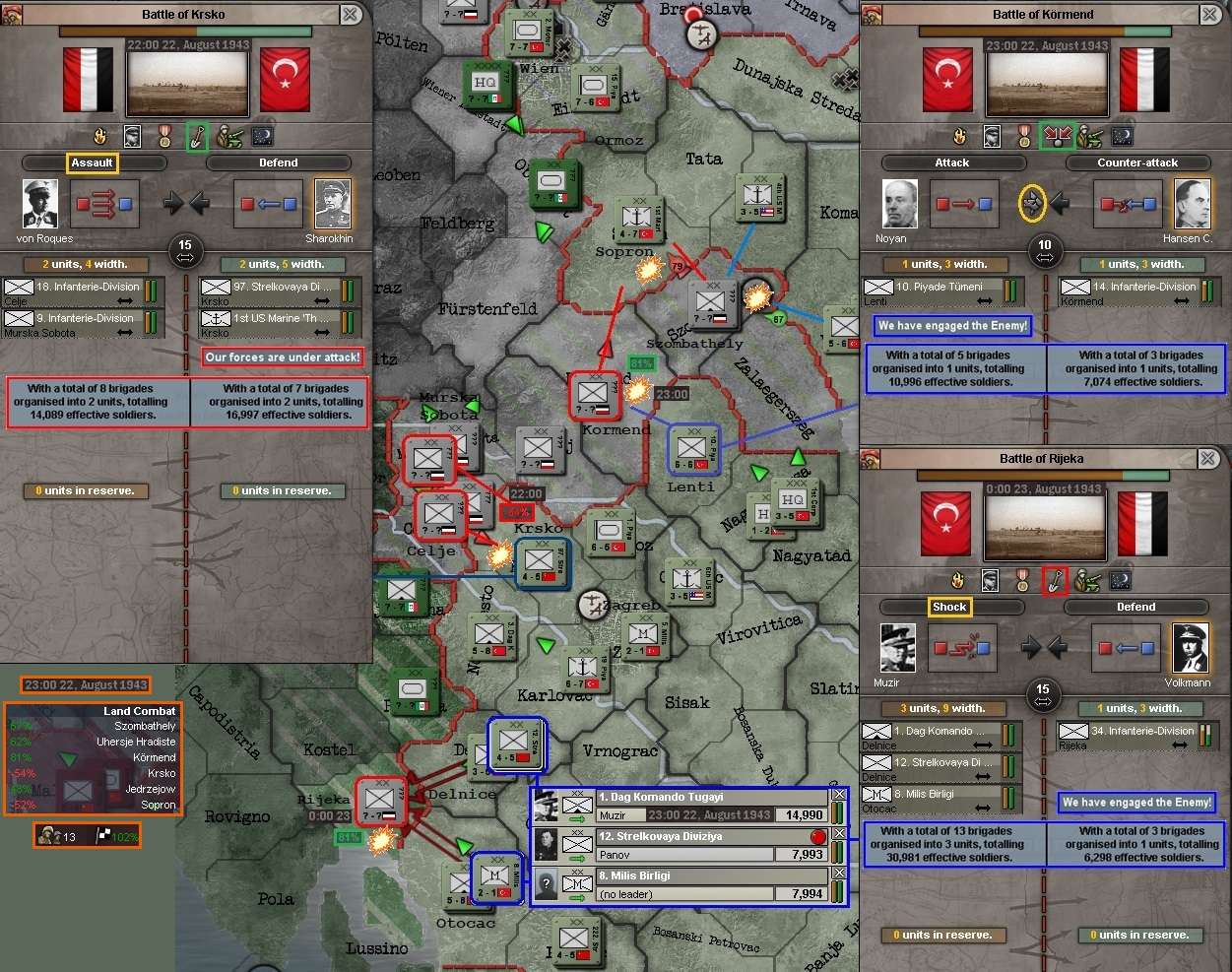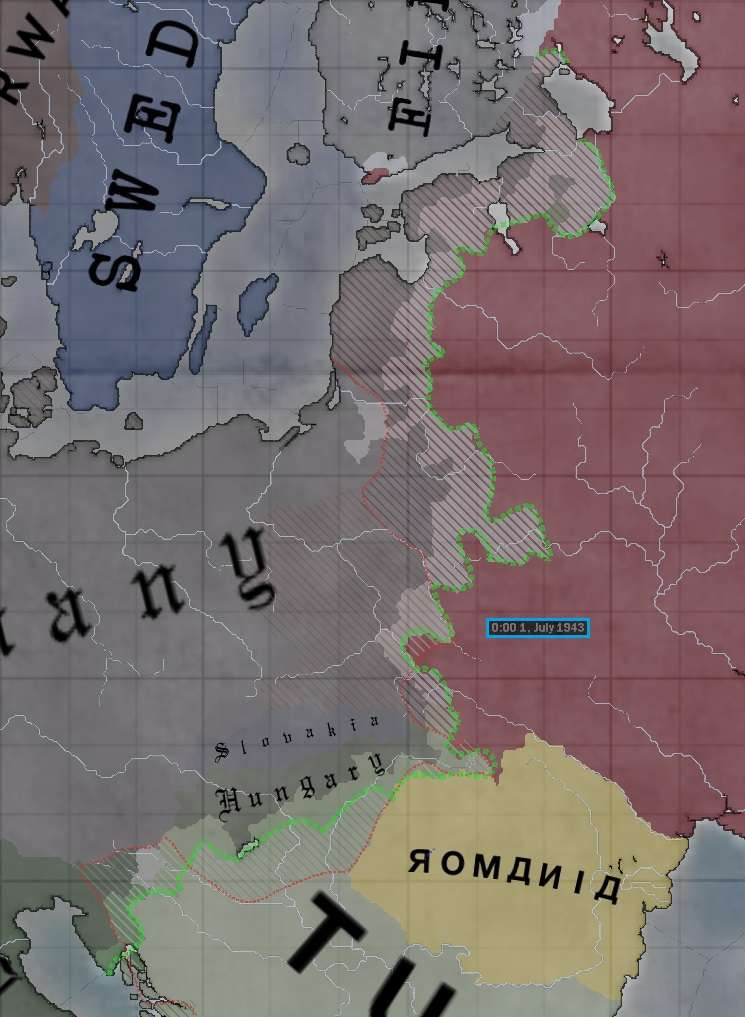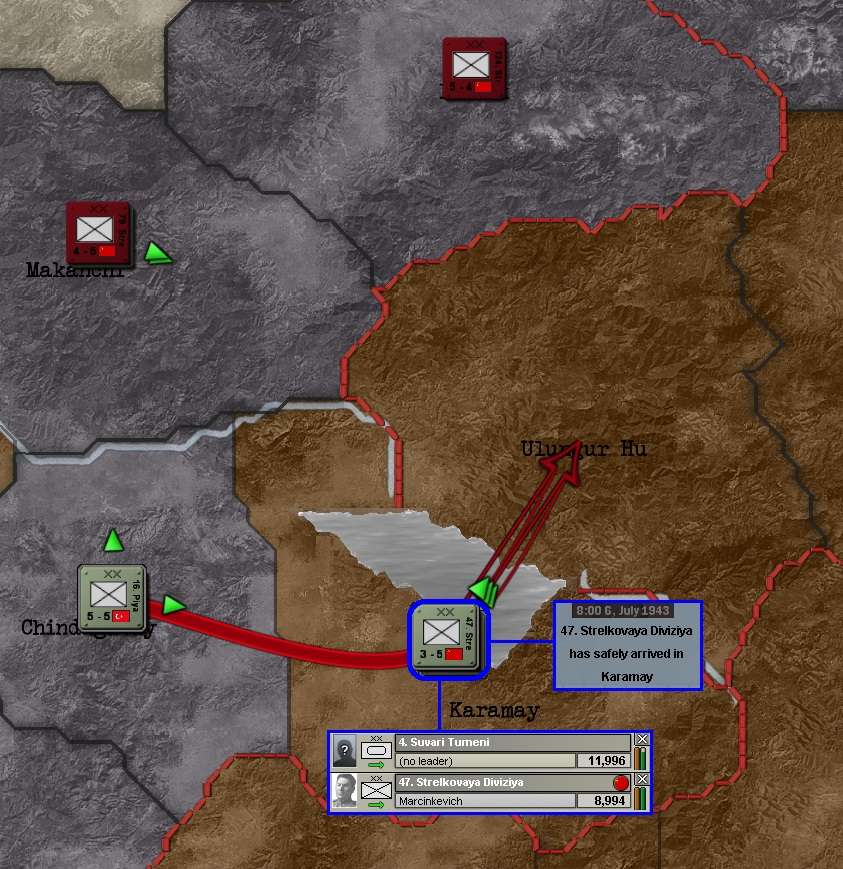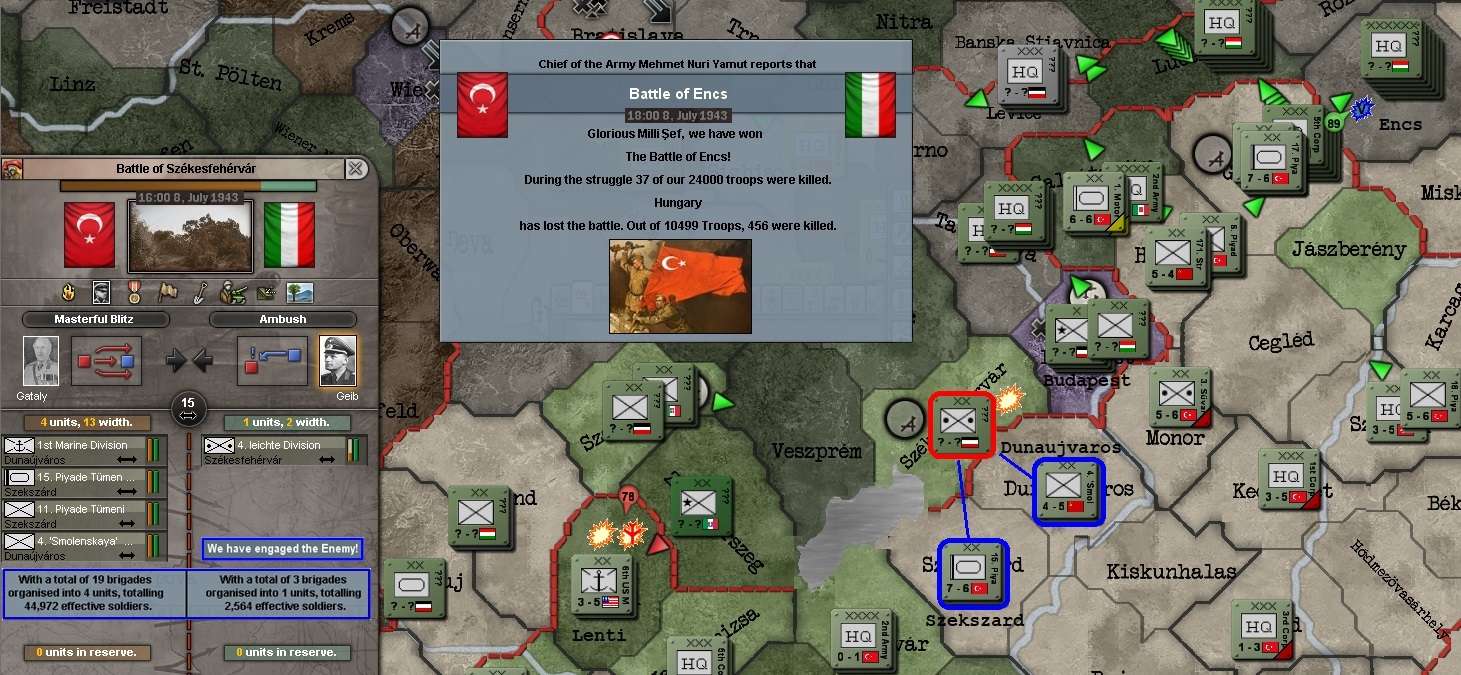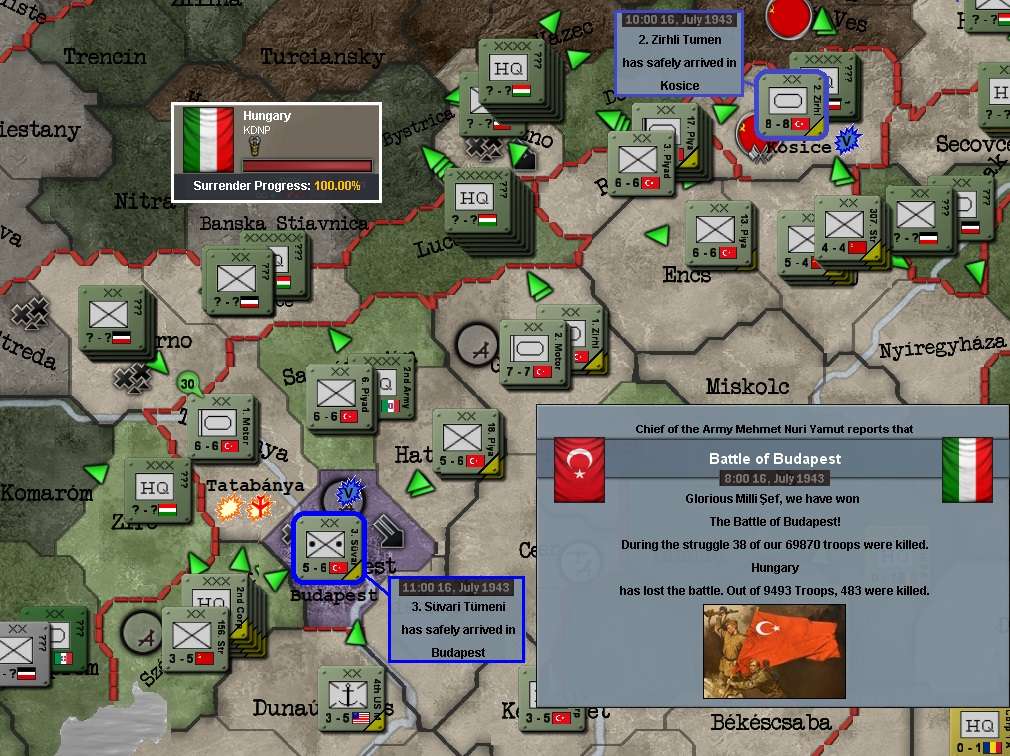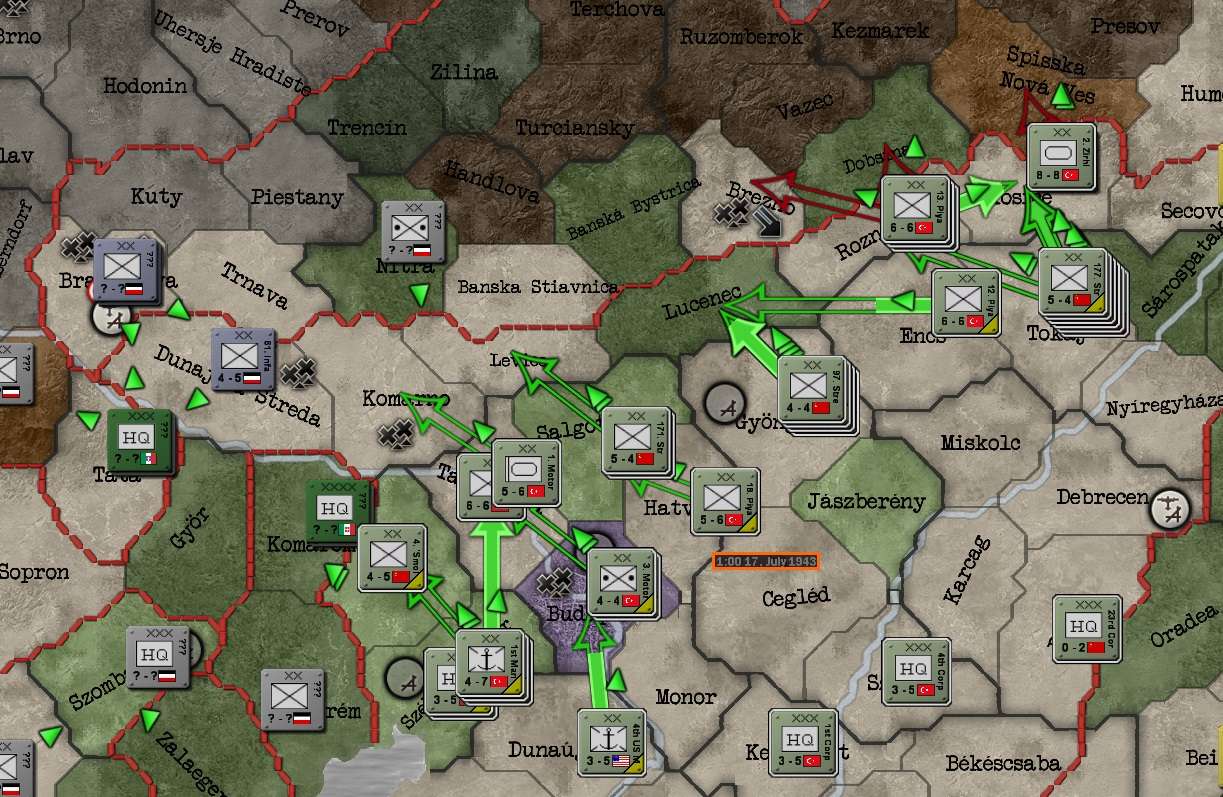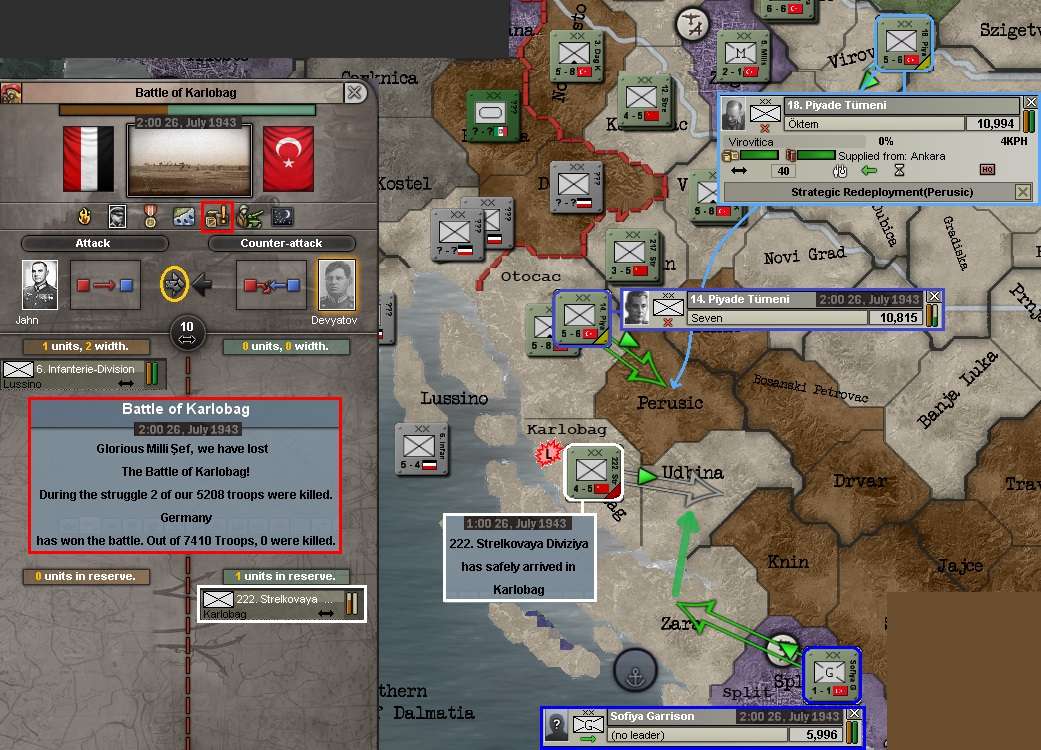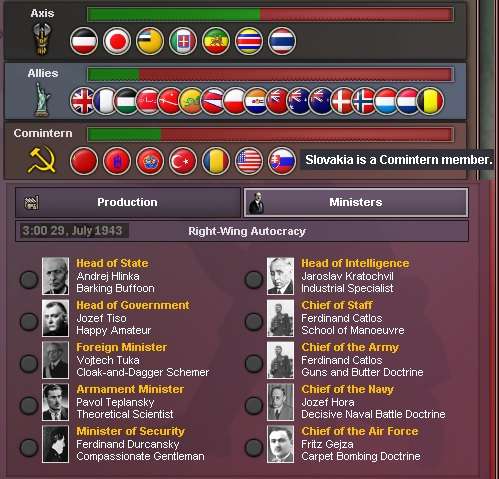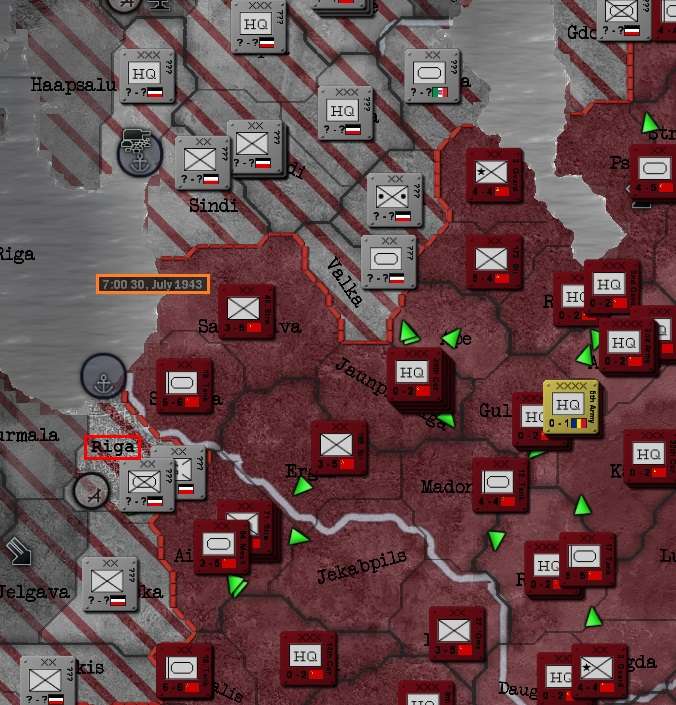Chapter 210: A Foot in the Door (9 to 22 August 1943)
Foreword
Turkey had just seized
Wien from a surprised and reeling Germany in a great symbolic blow against the filthy Nazi bratwurst-munchers. Rumours have emerged of a vitriolic Hitlerian rant of monumental proportions when the news was broken to him. Across the Balkan Front, the Turks seek to advance where possible while trying to avoid large-scale pitched battles, given the increasingly difficult manpower situation.
Hitler’s disposition would not have been improved by news from Army Group North, where the Soviets finally seem to have maintained a narrow cut-off on the Baltic coast, just north of
Riga.
Leningrad may remain in German hands, but like a Babushka doll the trapped Axis troops are now enclosed and pressure is also being slowly exerted on the old Polish border to its south.
Will the Germans crack? Or, as they have done many times in the Great Liberation War, will they manage a counterstroke to halt Comintern progress in the Balkans and free their trapped forces in Russia?
---xxx---
9 Aug 43
The only battle on the whole Turkish front still in progress on the morning of 9 August was in
Eisenstadt and that Turkish attack ended in victory at 3am. 15 Inf Div would continue the advance, while 4 SD was diverted to reinforce
Gänserdorf on the eastern approaches to
Wien.
On the Adriatic coast, 6 Mil Div arrived to reinforce 2 Mtn Div in
Otocac at 9am, given the Axis history of attacks there.
Over to the east in the Vistula Sector, 12 Inf Div secured
Terchova that afternoon, again unopposed. Axis resistance was still light in this sector, with large gaps in the line and evidence of their continued retreat.
The Turkish supply network seemed to be coping well enough with the recent advances and supply was good in most places.
The Germans reclaimed
Szombathely in western Hungary, south of
Bratislava, at 10pm: it had been briefly held by Turkey earlier in the month, but the Turks had been unable to hold it against a German counter-attack.
The last combat event of the day was a German probe against the mighty 1 Inf Div in
Ormoz at 11pm, but it had been easily defeated by 1am the next morning (one Turkish, 23 German casualties).
Air Damage Report. Three Italian air raids on
Tata in support of the defence of
Eisenstadt killed 360 troops from 15 Inf Div, but could not prevent a Turkish victory.
---xxx---
10 Aug 43
With a lull in combat continuing into the afternoon of 10 August, Turkish forces kept pushing forward into gaps in the line.
The same applied as the Vistula bridgehead was further expanded east of
Krakow, as Soviet forces gradually pushed forward from
Lwow.
Air Damage Report. Even though the Axis probe on
Ormoz was defeated early that morning, Italian air raids called in to support it lasted the rest of the day, killing 511 Turkish defenders.
OTL News Event: Sicily. For the second time in a week, General George S. Patton, Jr., struck a U.S. Army soldier after losing his temper. This time, his encounter was with Private Paul G. Bennet at the 93rd Evacuation Hospital in San Stefano, in Sicily. Patton asked Bennet what he was ill with, and Bennet, suffering from shell shock, replied, "It's my nerves... I can't stand the shelling any more." According to a medical officer who witnessed the attack, General Patton replied, "Your nerves, hell. You're just a God-damned coward, you yellow son of a bitch!" and then slapped him. The second incident was witnessed by a nurse, who told her boyfriend, a U.S. Army Captain in the public affairs detachment for the U.S. Seventh Army, and would make news worldwide when it became public three months later. Although demands would be made by members of Congress for General Patton to be relieved of duty, Patton would instead be reprimanded and would be made to apologise to both soldiers.
---xxx---
11 Aug 43
As the day began, the Turkish manpower reserve was at 10,000 and 3,060 replacements needed, even after the lower op tempo of recent days. No new battles started or air raids conducted, as Turkish units pushed forward, sticking their collective foot in the still-open door. And hoping it wouldn't be crushed if the door was slammed shut!
OTL Event: Eastern Front. Pulling back from the Soviet Union, Adolf Hitler ordered the creation of the "Eastern Wall", a line of defence on the eastern side of the Reichskommissariat Ostland, the German-occupied territory in Latvia, Lithuania and Estonia. [Comment: the Germans are in a bit more trouble already in this timeline.]
---xxx---
12 Aug 43
The early hours of 12 August saw
Eisenstadt taken after the earlier victory, while
Novy Jicin was occupied without a fight. Other divisions were still advancing into open space towards
Hodonin and
Prerov.
More generally, a regional map compiled that morning for Inönü at HQ 1st Army showed how much progress had been made in the summer offensive, given the previous front line had extended along the Danube from
Beograd to not far north of
Bucharest. A decent portion of southern Poland had now been liberated by Turkey.
An hour later, 17 Inf Div liberated
Rzeszow, on the southern bank of the Vistula, anchoring the eastern end of the bridgehead as the Turks waited for the Soviets to join up from the east.
The only new attack that day was another ‘back-stab’ ambush in
Terchova by the German 72nd Infanterie at 1pm – the treacherous swine! The Germans were fresh, but had only 1,660 soldiers left when the battle began, as they tried to break through to their own lines. The fight would drag on for another five days.
OTL Event: Sicily. German troops evacuated Sicily.
---xxx---
13 Aug 43
While the fighting in
Terchova went on all day and was now heavily in the Turks’ favour,
Hodonin was taken at midnight and
Prerov by 9pm that night. The Axis line remained very patchy from
Wien to
Katowice.
Asked for an explanation of the lack of Slovakian involvement on the side of the Comintern, not to mention their apparent harbouring and facilitation of German fifth columnists, Foreign Minister Aras reported that they were still formally in a truce with the Axis and indeed Allied and Comintern powers, despite the recent change of sides.
No option for a Call to Arms appears, even greyed out.
“Can we not call this recalcitrant President Hlinka to arms?” fumed an angry Milli Şef.
“Ah, er, I’m afraid not,” replied the Foreign Ministry staffer on the HQ.
“What, even though they are an ally and a puppet government of the UGNR!?” Inönü, who rarely lost his temper, looked in need of one of Interior Minister Kaya’s apoplexy tablets.
“I’m sorry, Milli Şef, I really don’t know what else to say. It’s the paradoxical Iron Law of diplomatic relations,” said the worthy as he begged his leave from the office.
---xxx---
14-15 Aug 43
With an advance in industrial production techniques on 14 August, attention was switched to further improving infantry warfare doctrine. And recent conquests had increased the leadership resources available to Turkey: these were all now invested in officer training.
The manpower reserve had increased a little to 11,000 with only 1,580 replacements required – an appreciable improvement in recent days, with few battles and no air raids.
Alas, this relative peace was broken at 1pm when the Germans attacked
Otocac, where the arrival of 6 Mil Div a few days previously allowed a strong defence, leading to victory late on the 15th. Italian air raids in support of the attack began late that night, but casualties would not be reported until the following the day.
And just before midnight on 14 August, 5 Inf Div pushed into
Staszów, extending the Vistula bridgehead to five provinces wide. Though at the same time more German divisions now seemed to be massing in the vicinity of
Katowice, which was quite exposed.
The air base in
Split received its level six facilities on 15 August and work continued to build it up to level seven straight away. It was likely to become the key Turkish air hub for future operations in Italy.
Air Damage Report. The first casualties from enemy air action since 10 August were taken after the Italians raided
Otocac three times on 15 August in support of the ultimately unsuccessful German attack, killing 489 defenders. There would be no further enemy air strikes until 21 August.
---xxx---
As 15 August drew to a close, Inönü received a strategic update. First, changes along the entire Patriotic Front since the beginning of the month were reviewed.
Note: The dark green dotted line marks Turkish advances in the Balkans since 1 August as the colours are hard to distinguish.
Agent SkitalecS3 reported that slow but steady progress was being made to squeeze the Baltic Pocket more firmly shut.
In the Far East, modest progress had been made on balance, with some give and take.
The British reported no changes in India since 1 August. In Australia, the Japanese had advanced a little north and south, but had not yet taken
Canberra.
---xxx---
16-17 Aug 43
Fighting continued in
Terchova and yet another ‘turncoat attack’ began in
Zilina, when the German 22nd Infanterie showed its true colours at 1pm on 16 August. However, this attack only lasted for three hours, ending in the Germans running after having 25 men killed, the Turks losing 32.
The fight in
Terchova had been a savage one, but it finally ended in the early afternoon of 17 August, leaving the enemy with fewer than 600 troops alive by the time it was over.
But the plague of turncoat attacks was not over: even as fighting ended in
Terchova, it broke out again in
Zilina. This time, the German 6th Infanterie had discarded their Slovakian camouflage (including dastardly overcoats with cravats) to attack 3 Mot Div, who were becoming regrettably used to this kind of perfidy.
Beware insidious, cravat-wearing German turncoats with hip-flasks and bad Slovakian accents!
That night, with several gaps still open in the Adriatic Sector from
Delnice to just
Sopron, just south of
Wien, more Turkish advances were begun.
OTL Event: Sicily. The US 7th Army, commanded by General George S. Patton, met the British 8th Army led by General Bernard Montgomery in Messina, completing the Allied invasion of Sicily. Allied artillery in Messina began shelling the Italian mainland.
OTL Event: Germany. The U.S. Army Air Force carried out the Schweinfurt–Regensburg mission, its first strategic air raid on German war production, attacking the ball-bearing factory at Schweinfurt, and the Messerschmitt aircraft manufacturing facility at Regensburg. General Ira C. Eaker, who commanded the Eighth U.S. Army Bomber force, made what Nazi official Albert Speer would later call "a crucial mistake", dividing the 376 American B-17 bombers into two groups, rather than concentrating on destroying the Schweinfurt factory, where production was cut by one-third, but continued. Sixty of the bombers were shot down, and 550 flyers were killed or captured.
---xxx---
18-19 Aug 43
With fighting only continuing in
Zilina at this stage, at 4pm 13 Inf Div was sent forward to secure
Cieszyn, guarding the southern approach to
Katowice.
OTL Event: Germany. In Operation Hydra, on 18 August three waves of Royal Air Force bombers struck Peenemünde. Eight RAF bombers were sent toward Berlin to divert German air defences. Colonel-General Hans Jeschonnek, 44, Chief of Staff of the Luftwaffe, shot himself the next day after learning about the damage.
Early on 19 August, 1 Mar Div took
Sopron without a fight. There were substantial German forces now in the general area, but they seemed to be stretch out in a long, thin salient. There were some hopes a pocketing a few of them as 10 Inf Div still advanced into
Lenti from the south.
OTL Event: Quebec City, Canada. The Quadrant Conference between the Chiefs of Staff of the United States, the United Kingdom and Canada, continued in Quebec City with the signing of the Quebec Agreement by U.S. President Roosevelt, U.K. Prime Minister Churchill, and Canadian Prime Minister King. The terms of the pact, officially titled Articles of Agreement Governing Collaboration between the Authorities of the USA and the UK in the Matter of Tube Alloys, would remain secret until 1954. "Tube alloys" was a codename for atomic weapons. The nations agreed to combine their atomic physicists and researchers to develop the atomic bomb, and not use the weapon against any other nation without joint consent. [Comment: Yes, for those ‘tube alloys’ fans among you, here is its first honourable mention here.]
---xxx---
20 Aug 43
12 SD retook
Delnice without opposition at midnight as 1 Mtn Div still advanced towards it, while 8 Mil Div and 217 SD were ordered up to bolster the front line, including MAJGEN Diskoerekto’s 3 Mtn Div in
Novo Mesto. 1 Mtn Div would returned to
Delnice by 8pm that night, joining 12 SD to strengthen the defence.
As the treacherous fight in
Zilinin still ground on, at 7am the Germans launched a major attack on 1 Armd Div in
Novy Jicin. The 1 Armd Div defenders were entrenched and had the best of the terrain and their initial defence remained strong, despite the shock and surprise of the attack.
Then just two hours later, to the east of
Krakow, an attack began on 5 Inf Div in the recently occupied
Staszów. This became far more serious at 2pm, when two more formations, including a not-before-seen SS Panzer Grenadier Division (the 11th), joined in. Strangely, a Polish Army HQ passing through took command of the battle for the Comintern! Even so, he seemed to be doing a good job and the superior armour of 5 Inf Div’s heavy tanks restricted the damage they were taking.
21 Aug 43
The two additional enemy divisions had reinforced the front line in their attack on
Staszów by 4am on 21 August, increasing the pressure on 5 Inf Div. Not wanting to let the situation drift and with the line thin in that area, spoiling attacks were organised east and west of
Staszów, both of which went in an hour later at 5am.
The attack on
Kielce was conducted by the powerful 2 Armd Div and was soon making inroads, but 17 Inf Div was attacking the 11th SS Pz Gren Div over the Vistula and, despite their superior armour, were soon up against it in
Sandomierz.
The suddenly increased battle tempo was eased slightly when victory came in
Zilina at 6am, with 185 Turks and 584 Germans killed in the turncoat battle.
But at the same time, things were becoming difficult in
Novy Jicin, where four Axis divisions were now attacking 1 Armd Div
[-70% attack progress] and Luftwaffe air strikes had begun. Again, Inönü was keen to stabilise the new front lines where he could, so twin spoiling attacks were launched on two of the provinces
Novy Jicin was being attacked from.
The attack on
Olomouc saw reasonable progress, but that on
Cesky Tesin was up against an entrenched enemy, in fortifications and on favourable terrain. It would be a tough slog. At 8am, 13 Inf Div made it to
Cieszyn, so they were added in to hit the flank of the defences in
Cesky Tesin, where they joined the battle in reserve at 10am. At that time, the manpower reserve had grown back to 13,000 with 580 needed for reinforcement, but with the sudden renewed intensity of fighting this would soon start to erode again.
The German bombers were taking a toll in
Novy Jicin as the morning wore on, so at 11am the old fighters of 1 AG (back to 100% strength and readiness by then) were scrambled from
Budapest to try to intercept them.
An excerpt of the key characteristics of the current German interceptor. A deal better than even our latest La-7s.
Unfortunately, they were themselves intercepted at midday by three Luftwaffe fighter wings without coming to grips with the bombers and were (unsurprisingly) badly cut up. The ill-fated experiment was called off when they returned to base.
At 3pm, 10 Inf Div occupied
Lenti in the Adriatic Sector, increasing hopes of another pocketing effort there. And at 4pm, 2 Armd Div won their fight for
Kielce – and continued advancing to take it (51 Turkish and 359 German casualties).
With more damage to repair in
Budapest and the new La-7s of 9 AF still working up, they were re-based
[Reserve mission to preserve org] to nearby
Gyöngyös to continue their preparations after 1 AG limped back to
Budapest.
Victory came in the defence of
Staszów at 9pm (319 Turkish and 751 German casualties), allowing the spoiling attack on to
Sandomierz be called off (74 Turk, 82 German casualties).
Air Damage Report. German bombers struck
Novy Jicin in support of their attack in two raids that would continue into the next day. And the Italians began bombing
Prerov that evening, as defensive missions to counter the Turkish spoiling attack on
Olomouc.
---xxx---
22 Aug 43
By 1am, the situation in
Novy Jicin was getting worse and neither of the spoiling attacks had provided relief: 1 Armd Div’s organisation was down to around 30%. But they still tried to hold out, hoping the tide could be turned.
In
Delnice, the three divisions (1 Mtn Div plus 12 and 217 SD) there would now stay in place: at 3am, 19 Inf Div (now recovered from earlier battle damage) would push up to
Novo Mesto from
Karlovac instead. And in western Hungary, Turkish infantry and US Marines attacked the
Szombathely salient at exactly the same time the Germans there were launching an attack on 1 Mar Div in
Sopron. Other Turkish formations were also ordered to take up advanced positions in the vicinity. Another general engagement threatened.
With those battles beginning and the situation in
Novy Jicin becoming an expensive and failing effort, 1 Armd Div was ordered out to Prerov at 8am and both the associated spoiling attacks were discontinued, all with moderate to heavy losses.
Just an hour later, the Germans launched their own attack on
Prerov. Inönü knew it was critical that 8 Inf Div, without a qualified commander, hold on long enough to allow 1 Armd Div to retreat through them. Despite the manpower issues, the Turks were adamant: the Fascists would be resisted with all available force. The cost would be counted later as MAJGEN Gürler of 6 Inf Div led Turkish and Soviet troops in a flanking attack on
Uhersje Hradiste.
The ploy worked, with the
Prerov attack called off by 1pm. But rather than cease the attacking on
Uhersje Hradiste, Inönü doubled down by reinforcing it from
Hodonin, making the odds more favourable, even as the Axis bombers switched their attention to the new line of attack from
Hodonin. He was keen to remove this small German salient in the Turkish defensive line. But
Prerov became more isolated when 2 Pz Div occupied
Novy Jicin at 9pm that night.
That afternoon in
Zurich, Cennet was talking to Ambassador ‘Mike’ Ceylan in his private office.
“My dear Cennet, I’ve just received a cable from the Foreign Ministry in Ankara,” said Mike languidly. “The Soviets have appointed a young new Ambassador to the US. Here is the brief report on him.”
News Report: Washington DC, US. Andrei Gromyko has been named as the new Soviet ambassador to the United States. [Note: In OTL, this was part of a surprise announcement that long time ambassador Maxim Litvinov (still Foreign Minister in the ATL) was being removed from the post. Litvinov had departed Washington in May after Joseph Stalin summoned him back to Moscow.]
Andrei Andreyevich Gromyko (Russian: Андре́й Андре́евич Громы́ко) b. 18 July 1909 is a Soviet Belarusian politician and diplomat. Gromyko's political career started in 1939 with his employment at the People's Commissariat for Foreign Affairs. He is only 34 as he starts his new job as the Soviet ambassador to the United States.
“Yes, Uncle Mükkerim, very interesting, I suppose,” replied Cennet as she hand the short bio and picture back to her boss – who of course doubled as the S.I.T.H. chief for Western Europe.
“When we finish here, I want you to report to our passport section. They will have a brand new diplomatic passport waiting for you. In the morning, you will finalise travel arrangements for your new posting.”
“Oh, you mean I’ll be leaving my Italian Job?”
“Yes, for now anyway. Nothing much is happening there and our station chief in Rome plus the assistance of our ‘business consultant’ Vito Corleone can keep things covered. Your talents are wasted there now. I will get a new liaison officer to work with young Sforzini and the CLN resistance cells.”
Cennet was a little disappointed, but simply shrugged and nodded. He had been a bit of ‘fun on the side’, but was as nothing compared to the interests of the nation.
“You soon commence as our new Cultural Attaché in Washington DC,” Mike continued. “It should be an enjoyable official role. And there are, of course, a few items of business Ankara will want you to conduct. This is a promotion – and well deserved. That will be under different supervision, as you will be leaving my area of responsibility. It has been a pleasure working with you. Good luck in your new role – though I know luck will have little to do with it.”
“Thank you, Uncle Mükerrim. You have taught me much. I hope our paths cross again.”
“As do I,” he said as he gave her an avuncular embrace in farewell. “I do hope we both live to see each other again. One can never bank on that in this game.”
“I do hope we both live to see each other again. One can never bank on that in this game.”
---xxx---
Undaunted and discounting manpower considerations (for now, at least), Inönü remained determined to keep the pressure up on the enemy both for local reasons on the Balkan Front, but also for strategic considerations the Soviets (with Romanian support) battles to destroy Army Group North and advance into Poland went on. Turkey would do its part to maintain a ‘full court press’, even if it hurt.
He therefore launched a new offensive in the Vistula Sector after 2 Armd Div took
Kielce at 10pm. Two Soviet divisions began a night attack on the German 22nd Infanterie defending
Jedrzejow, hitting them at 11pm. When it appeared resistance could be difficult to overcome, MAJGEN Tunaboylu’s 4 Inf Div was ordered to advance to strike the enemy’s flank: they would not join the attack until the following morning, when the effect would be judged.
Also at 10pm, the Germans attacked
Wien, but what turned out to be a probe was easily repulsed just an hour later (no Turkish and 36 German casualties). Simultaneously, they also attacked the Soviet and US divisions holding
Krsko. The battles for both
Sopron and
Szombathely were also both well advanced.
Inönü’s response was to strike back with maximum force. 10 Inf Div’s flanking attack on
Körmend went in at 11pm to try to save
Sopron, while a new attack was launched on
Rijeka with three divisions from
Delnice and
Otocac, in the hope of providing more distraction but on favourable tactical terms.
The quiet period that had gone before was clearly over. While manpower still held at 13,000 in reserve, this was bound to fall again. The consolation was that the Germans, against whom the vast bulk of the fighting was directed, were assessed to be in a far worse manpower position and had the Soviet onslaught to contend with as well. Officer strength had now crept up to 102% with recent additional training efforts.
As 22 August ended, there were still six battles in progress across the entire Balkan Front, all of them closely contested. In the two weeks from 9-22 August (and not counting the continuing battles), Turkey had lost 2,916 men to ground combat and 3,153 to air strikes for a total of 6,069 killed. They had inflicted 5,005 ground combat losses on Axis (mainly German) forces over the same period. This brought total casualties for the whole month to date up to 10,073 for Turkey and 8,787 for the Axis.
Air Damage Report. German bombers killed 776 defenders in
Novy Jicin in four raids from 21-22 August, contributing to the Turkish loss there. The Italians only hit
Prerov twice from 21-22 August, killing 418 in defending the earlier Turkish spoiling attack on
Olomouc. The Germans hit
Cieszyn three times that day for 483 killed, part of their defence against the flank attack on
Cesky Tesin. And Italian raids began that evening on
Hodonin in defence of
Uhersje Hradiste, the first one killing 116 men that night. This uptick in enemy air activity would no doubt soon be reflected in replacement demands from the front.
News Report: Washington DC, US. The identity of "Gertie from Berlin", who broadcasts Nazi propaganda to English-speaking radio listeners, has been revealed by the FBI to be Gertrude Hahn, an American citizen and native of Pittsburgh. Miss Hahn, who had moved to Berlin in 1938 when her father decided to return the family to Germany, grew up in Mount Oliver, Pennsylvania. [Comment: perhaps S.I.T.H. should pay this ‘Gertie’ a visit in Berlin.]
---xxx---
Coming Up: How determined will the current apparent German counter-offensive prove to be? And what effect might that have on their ability to relieve the surrounded Army Group North or resist Soviet advances into eastern Poland? Is Inönü willing to risk running down his manpower reserves to zero in the short term, to lock in longer terms gains, now he has Turkey’s ‘foot in the door’ that opens into Germany’s soft/medium/hard (your choice) underbelly?
More widely, can the UK hold India and is Australia doomed or can it recover from the Japanese invasion? Will the British
ever finish off those stranded Italian HQs in Libya and end the North African campaign, let alone invade mainland Europe, or even just Sicily?
And what might happen in the largely dormant ‘Secret War’ for the rest of August – more ennui as Italian national unity is slowly eroded, now without Cennet’s direct personal assistance? Or will there be some more serious Midnight Escapades, at home or abroad? Is Perse’s sabbatical in the US selling many war bonds?


